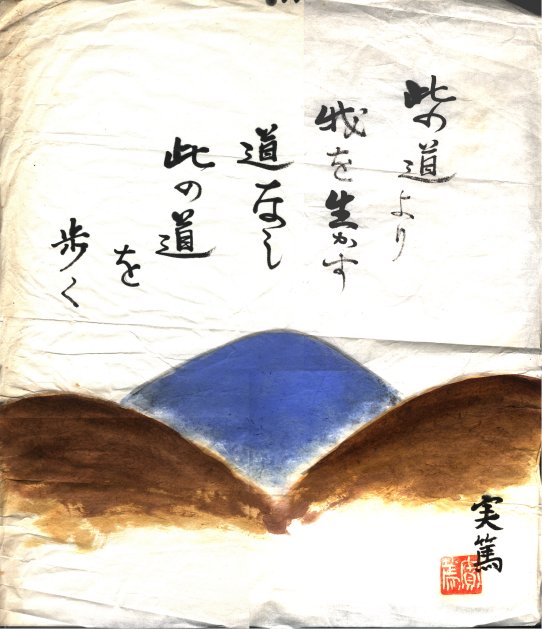

Zen Painting by Contemporary Japanese Master Painter and Novelist Saneatsu Mushanokoji (1885-1976)
日本近代名畫家及作家武者小路實篤(1885一1976)禪畫
Mushanokôji Saneatsu(1885-1976)
Mushanokôji Saneatsu, the central figure in the Shirakaba (White Birches) group of writers in the second decade of the twentieth century, was born into the family of a Tokyo viscount. As a junior high school student at the Peers’ School (Gakushûin), he made friends with Shiga Naoya. In high school he came under the sway of the Tolstoyan ideals of self-denial, asceticism, and charity. Mushanokôji left the sociology department of Tokyo University without graduating, and with Peers’ School friends Shiga, Kinoshita Rigen, and Ôgimachi Kinkazu formed a literary study group called the Jûyokka Kai (The Fortnight Club).
In 1910, this group started publishing Shirakaba magazine. Under the influence of the Shirakaba group, Saneatsu began to move away from Tolstoy’s idea of self-sacrifice and toward an ideological posture of confident self-affirmation. Omedataki hito (An Innocent, 1911) is the most important work in this vein, and this was followed by Seken shirazu (Babe in the Woods, 1912). With the outbreak of World War I, Saneatsu turned again for inspiration to Tolstoyan humanitarianism. He urged respect for “the will of nature and the will of man,” arriving at the belief that making use of each individual’s potential was the best way to ensure the happiness of all mankind. A rapid succession of major works soon followed: Sono imôto (His Sister, 1915), a play turning on the dilemma of being caught between self-love and love for mankind; Kôfukumono (A Happy Man, 1919) a novel presenting Mushanokôji’s image of an ideal human being; and Yûjô (Friendship, 1920), a novel that portrays the victory of the human ego as it wavers between friendship and love.
The same sort of idealism can be found in the autobiographical novel Aru otoko (A Certain Man, 1923) and the play Ningen banzai (Three Cheers for Mankind, 1922). Mushanokôji even attempted to put his ideals into practice in 1918 by creating a quasi-socialistic “new village” (Atarashiki Mura) in Hyûga, Kyushu. (Mushanokôji left the village in 1926, and a dam project forced it to relocate to Saitama Prefecture in 1939, where it still operates.) Mushanokôji faded into the literary background in the 1930s and 1940s, although he gained something of a reputation as an artist specializing in the depiction of vegetables like pumpkins and potatoes. Mushanokôji’s last popular word was Shinri sensei (The Teacher of Truth, 1951), a novel that once again holds up for the reader’s admiration a life sincerely led. It is this sincere humanitarianism that continues to appeal to those who admire his works.
White Birch Society [Shirakabaha].
Japanese society of literary figures and artists formed in Tokyo in 1910 by, among others, the novelists Saneatsu Mushanokoji (1885–1976) and Naoya Shiga (1883–1971), and the painter and critic Muneyoshi Yanagi. The society produced an eponymous monthly journal, the first issue of which appeared in April 1910. The aim of the journal was to discuss ideas on Western literature and art and to introduce to Japan the work of such major Western artists as Cezanne, van Gogh and Rodin. The society greatly influenced young Japanese artists, such as Ryusei Kishida, whose early work was inspired by late Impressionism, and who was a founder of the Grass and Earth Society of Western-style painters. The society also held exhibitions of Western art (principally reproductions), including a show of Western prints (Tokyo, 1911) and another showing the work of Rodin, Renoir and Bernard Leach. The society’s journal ran for 160 issues, until August 1923.
武者小路實篤(1885一1976)
明治18年(1885) )5月12於東京府?町區(即現在的東京都千代田區)出生, 父親武者小路實世, 母親秋子。23年入讀初等學校,39年(1906)高等學校畢業,同年九月進入東京帝國大學,專修哲學科社會學。 40年(1907)退學, 轉而開始專注於文學創作,43年(1910)與友人志賀直哉、有島武郎等創辦『白樺』文學雜誌,以介紹及評論西洋美術為主, 並且宣揚人道主義與理想主義。 大正7年(1918), 為追尋烏托邦的夢想,在宮崎縣創建了「新理想村莊」(類似人民公社)。 大正11年(1922)與飯河安子結婚。大正12年(1923)日本關東大地震, 『白樺』停刊, 轉而熱心於繪事。昭和4年(1929)在第4回國畫展中, 展出繪畫作品。昭和6年(1931)昭和7年(1932),加入日本畫會為會員。昭和14年(1939)在琦玉縣創建另一所「新理想村莊」。昭和23年(1948),創辦『心』文學雜誌,並與文壇、畫壇中43人的組織「生成會」。昭和26年(1951),獲頒文化勳章。昭和35年(1960), 與梅原龍三郎、中川一政等創立「這道會」。昭和51年(1976) 4月9, 在其妻子去世兩個月後, 在東京中風逝世,享年90歲。
Click Here to See Other Japanese Paintings
Click Here to See Other Paintings
Click Here to Go Back to Homepage